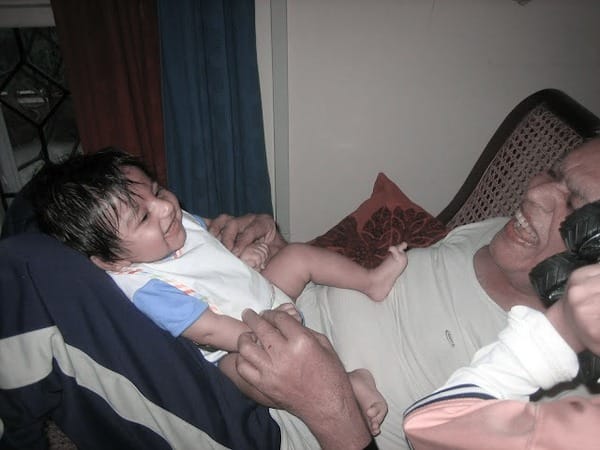Go on Google and parenting terms hit you faster than a screaming toddler launching himself at mom, in supersonic speed. But the one that always gets me worried that I belong to the Neanderthal era and cracks me up at the same time has to be the much used and abused term called ‘Attachment parenting.’
Coined by Dr William Sears who wrote a plethora of baby books, it’s one of those terms that certainly doesn’t apply to India. In fact the good American doctor was definitely not thinking of us when he coined it because in India we are always attached to our child.

We are Indians. We like piling on. Pic: Reshmi Chakraborthy
As described by Dr Sears, ‘Attachment parenting’ is a theory that suggests a stronger emotional bond between parent and child. Followers of this theory usually continue breastfeeding their children for extended periods of time, let the baby sleep in close contact with them and usually carry the baby in close contact in a sling (stylishly termed babywearing).
Now that’s something we do all the time right? At home or at work, in the gym or the temple, in the mall or a crowded bazaar, we are ALWAYS lugging baby around, either in our arms or in a sling or in a pram or depending on the place (definitely not a crowded bazaar), the said child is tagging along holding on to your hand or dupatta or purse or whatever appendage he can find.
If you are lucky enough to leave the child behind with someone trustworthy at home, you’re sure to encounter a friend or neighbour in the lift or the parking lot who will express great surprise and disappointment at seeing you alone and being denied the pleasure of pulling the cuddly-thing’s cheek.
No wonder our Hindi movies are full of references to Maa ka anchal/maa ka pallu and so on. All the script writers and lyricists must have done a fair bit of toddling, holding on to some part of their mom’s sari.
Attachment parenting is what comes to us naturally, we just didn’t know the name for it until now. Well our generation of mommies probably do know, but our mothers, mercifully did not. In fact it’s quite like ‘co-sleeping,’ which has the Western world of parents divided. While one group seems to believe it could put infants at risk of suffocation and strangulation, the other feels it helps babies fall asleep faster and increases the bond between child and parents.
While many of us here put a newborn in his own cot but in the same room (with the cot dragged as close to bed as you can if you are me), co-sleeping is an issue that doesn’t seem to bother us much. Probably because all of us grew up co-sleeping, as babies at least.
Or as one mother puts it, at least until the child is around 5 or 6 years of age when he seems to develop arms and legs that start shooting off in every direction, turning the bed into a football field. Ask me, I’ve been trying to get the older one to move to his own room for over a year now without much success.
We do have some Western ideas to be thankful for. Car seats are one of the best examples. Or highchairs. If you have or are using them, I’m sure you can vouch for the usability and safety, despite the daadis and naanis tut tutting everytime junior is strapped in. Who knows, maybe 20 years down the line I’ll tut tut as my son looks through babycare books, and decides not to follow ‘Attachment parenting.’⊕